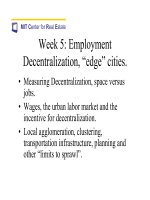Tài liệu The Office Market, and the Labor Market docx
Bạn đang xem bản rút gọn của tài liệu. Xem và tải ngay bản đầy đủ của tài liệu tại đây (669.44 KB, 27 trang )
MIT Center for Real Estate
Week 5: Employment
Decentralization, “edge” cities.
• Measuring Decentralization, space versus
jobs.
• Wages, the urban labor market and the
incentive for decentralization.
• Local agglomeration, clustering,
transportation infrastructure, planning and
other “limits to sprawl”.
enter for Real E
National % of office space in CBD as opposed to
MIT C state
Suburbs
(source: CBRE)
enter for Real E
Washington D.C.: City and Suburban
MIT C state
Office Space
(source: CBRE)
0%
10%
20%
30%
40%
50%
60%
70%
80%
90%
1950
1953
1956
1959
1962
1965
1968
1971
1974
1977
1980
1983
1986
1989
1992
1995
1998
2001
District of Columbia Suburban Maryland Northern Virginia
enter for Real EMIT C state
Decentralization “flattens” the
cumulative W.D.C. spatial distribution of
office space.
[Source: geo-coded building data, CBRE]
0%
20%
40%
60%
80%
100%
120%
Pe rcent of Stock
0
2
4
6
8
10
12
14
16
18
20
22
24
26
28
30
32
M iles out from Center
1980 2002
enter for Real E
The Distribution of Office Using Jobs Across The
MIT C state
NY CMSA
[Source: Employment Zip file, 1999]
120%
100%
80%
60%
40%
20%
0%
0
6
12
18
24
30
36
42
48
54
60
66
72
78
84
90
96
102
108
Information, Real Estate, Prof essional Services
Finance
Management of Companies, A dministrative Services
.5
enter for Real EMIT C state
Cummulative Employment and Population (%)
Figure 7: Los Angeles Spatial Distributions
Employment Population
1
.75
.25
0
0 10 20 30 40 50 60 70
Distance from Center of the CBD (miles)
enter for Real E
Figure 6: New York Spatial Distributions
Cummulative Employment and Population (%)
Distance from Center of the CBD (miles)
Employment
Population
0
5
10
15
20
25
30
35
40
45
50
55
0
.25
.5
.75
1
MIT C state
MIT Center for Real Estate
b
Concentration = ∫ e(t) dt
0
b
Where: e(t): cumulative fraction of jobs (population) at distance t
b: distance at which 98% of population live.
Figure 8: Employment and Population Centralization
in a Sample of 120 Cities
Employment Centralization
Honolulu
Wichita
DesMoin
.8
Syracu
Erie
Rochest
Jacksonv
Birming
Oklahom
Jacksonv
Pensac
Tulsa
Sarasot
Tucson
Fresno
Anchor
Lansing
SanAnton
Austin
NewOrle
Sacram
Montgom
Columb
Charlest
Portland
AtlCity
Chatta
Minneap
FortWay
Allent
Toledo
ColSpr
Biloxi
Peoria
Houston
SaltLake
Wash
Lincoln
.7
.6
Columb
Clevel
.5
Albany
Atlanta
August
Baltim
BatonR
Boston
Buffalo
Canton
Charlot
Chicago
Cincinn
Columb
CorpChr
Dallas
Dayton
Daytona
Denver
Detroit
ElPaso
Evansv
Flint
FtMyers
GrRapids
Greensb
Greenv
Harrisb
Hartford
Huntingt
Indianap
Kalamaz
Kansas
Knoxv
Lancast
LasVegas
LexFay
Lrock
LosAng
Louisv
Lubbock
Madison
McAllen
Memphis
Miami
Milwauk
Mobile
Modesto
NewYork
Norfolk
Omaha
Orlando
Philad
Phoenix
Pittsbu
Providen
Provo
Raleigh
Reading
Reno
Richmond
Roanoke
Rockf
StLouis
Salem
SanDieg
SanFran
SantaB
Savannah
Scranton
Seattle
Shrevep
SthBend
Spokane
Springf
Stockton
Tampa
Waco
Waterb
WPalmB
Worcest
Youngst
.5
.6 .7
Population Centralization
enter for Real E
Employment Dispersal and commuting
MIT C state
• If people can commute only inward (not true but a useful
assumption!). Then the number of people traveling inward
at any point is the difference between the cumulative
number of jobs located up to that point and the cumulative
number of workers living up to that point.
• Proof: if the number of inward travelers at distance (t) is
less than this difference then not all jobs up to t are being
filled. If the reverse, then there are more commuters than
jobs up to t and jobs beyond t are not being filled.
• Implication: jobs must be more centralized than residences
for positive traffic flow in the allowed direction.
• With complete job-residence dispersal: no commuting!
• With centralized employment traffic worst at the edge of
the business district
enter for Real EMIT C state
F ig u re 4: L an d U se an d T ravel C o sts,
2 m illio n in h ab itan ts, m ixed u se city, h igh ag g lo m eratio n
1.2
500
450
% of Total
1
400
350
0.8
300
0.6
250
200
0.4
150
100
0.2
50
0
0
10 20 30 40 50 60 70 80 90 100 110 120 130 140 150 160 170 180 190
Dista nce (1/10 M ile)
Cum ulative E m ploym ent Cum ulative P opulation Travel Costs/mile
Figure 6: Land Use and Travel Costs,
2 million inhabitants, mixed use city, low agglomeration
0
1
0
50
0.2
0.4
0.6
0.8
1.2
% of Total
100
150
200
250
300
350
10 20 30 40 50 60 70 80 90 100 110 120 130 140 150 160 170 180 190
Distance (1/10 Mile)
Cumulative Employment cum ulative Population Travel Costs/m ile









